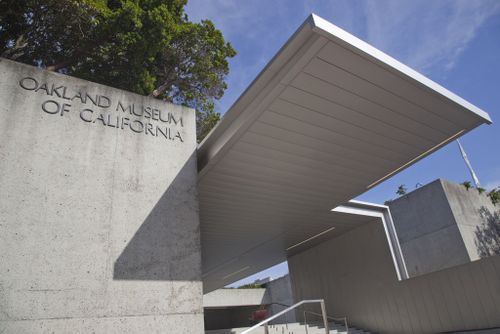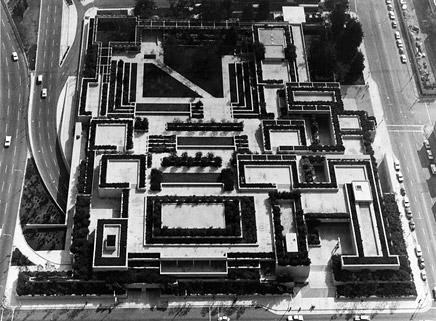
A 1969 Oakland Museum Gets $62m Renovation
In 1969, it looked more like something from Babylon or Teotihuacan than any museum people had seen. Yet even as the Oakland Museum opened then to the applause of architecture critics, it was upstaged by the trials of Black Panthers at the Alameda County Courthouse across the street.
The Oakland Museum of California, an ensemble of concrete blocks and luxuriant gardens designed by Kevin Roche and landscaped by the architect Dan Kiley, has reopened after a $62 m renovation, most of it invisible.

Oakland Museum of California, 1968.
Christened as a “museum for the people” in 1969, the OMCA (as it would later be called) triggered a surge in US museum design and construction. The project would inspire architects and clients, yet it never fueled either tourism or the local economy. Bilbao this wasnt, and still isnt.
Roche imagined it as an anti-museum. Poured-concrete blocks challenged the norm of neo-classicism for most American museums. Roche called the conventional museum profile “pompous and repelling.” The plantings on its roofs and in its courtyards which softened the structures hard lines reflected an early foray into environmental architecture – although its internal systems, modernized in this makeover, were anything but green back then. The museums park-like atmosphere was another alternative to the institutional norm, a safe-haven from the urban battlefield that Oakland had become at the time. Multiple doors defied the notion of a single ceremonial entrance, although fear of crime kept most of them closed.
Roche, who took over the job after his boss Eero Saarinen died of a brain tumor at age 51 in 1961, was designing a paradox, a community cultural citadel – a park-like public space where visitors could come, regardless of whether they were looking at art . “In terms of design and environment, it “may be one of the most thoroughly revolutionary structures in the world,” opined Ada Louis Huxtable in the New York Times before the building opened. The total cost was some $5 million.
Oaklands populist spirit symbolized by its new museum was contagious. At the Metropolitan Museum of Art, director Thomas P. F. Hoving – nothing if not a populist himself — saw the ambitious plans and signed Roche Dinkeloo and Associates to design its master plan, best-known for the airy wing that houses the Temple of Dendur and a massive pyramidal sepulcher for the art collection of Robert Lehman. (The Lehman Wing is the closest that Roche has come to being pompous.) Kevin Roche won architectures Pritzker Prize in 1982.
Only 4500 sq. ft. are added to OMCA in the renovation by Mark Cavagnero Associates of San Francisco, whose bid to modernize and retrofit the structure was more reasonable than one provided by Roches firm, according to museum management. (Roche has not spoken to anyone at the museum since the job went to Cavagnero, and did not attend reopening ceremonies.)
The most noticeable transformation encloses previously open sculpture courtyards as galleries, topped with stainless steel that tilts upward slightly, altering the buildings rectilinear uniformity. The new spaces can accommodate contemporary art that wouldnt fit otherwise under 12 foot ceilings. The museums main entrance and stairwells that were once open to the air are now also covered.
Slightly expanded, the museums Gallery of California Art – most of one floor – is its most revealing exhibition space, in the works themselves and in what they say about the history of the place where they were made. Dorothea Langes archive, donated by her husband, numbers some 6000 prints and 25,000 negatives. A gallery is devoted to Lange, with documents viewable in flat-file display cases. Another room shows work by Mine Okubo, the assistant to Diego Rivera, who was imprisoned in Japanese-American internment camp during World War II. Rivera-inspired work by Okubo is on view, including Okubos self-portrait, plus drawings made while in wartime detention. (Okubo moved to New York after the war.) The Bay Area Figurative Schools defiant response to Abstract Expressionism is present in paintings by David Park and others. Photography from the last 150 years, a strength of Oaklands collection, is represented by Carleton Watkins through Edward Weston to the present.
Works made with found objects by Armando Lerma and Carlos Ramirez, who call themselves The Date Farmers, are an update on California history to include the harsh nomadic life of the 21st century. If arte povera has a third generation, this is it.
These are all good reasons for tourists to visit Oakland, and there are many more, yet visitors who deplane by the thousands at the vast former military Oakland Airport head right across the bay. Attendance at OMCA is 200,000, which could rise once word of the reopening gets out.
Will a renovated OMCA change Oakland? Not overnight, even though its walls are bulletproof. A few days before a 31-hour marathon reopening, a gunfight erupted at a funeral on the street. A school nearby was locked down, sending parents into panic. Street theater, insiders say, has always been part of the citys culture.

Thanks for expressing your ideas. I might also like to mention that video games have been ever evolving. Today’s technology and enhancements have helped create practical and enjoyable games. These kind of entertainment games were not really sensible when the concept was first of all being tried. Just like other forms of technological innovation, video games also have had to grow via many many years. This itself is testimony towards fast growth of video games.